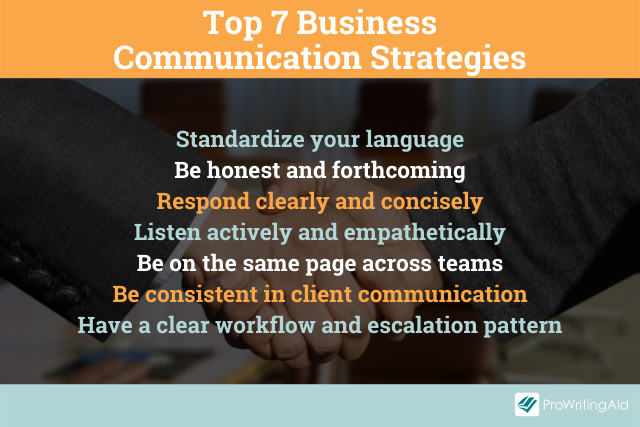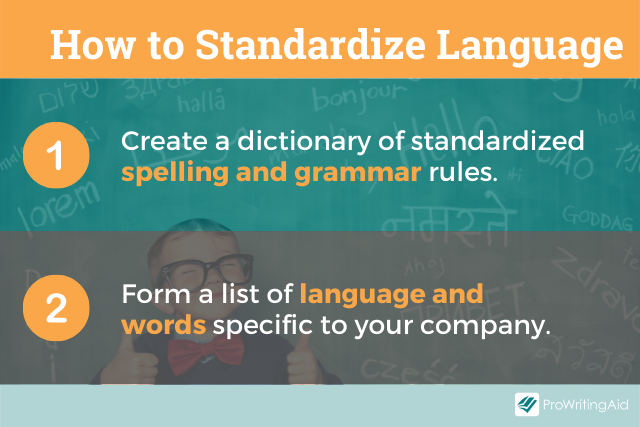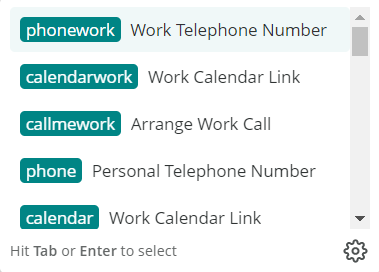
If there’s one thing that will negatively impact both customer experiences and employee satisfaction every time, it’s poor business communication strategies.
But the good news is that the same is true in reverse. If you want to improve client experiences and employee satisfaction, prioritizing effective communication strategies in business is the easiest way to do so.
Today, we’re looking at the top seven ways to improve your business communication strategies.
7 Effective Communication Strategies in Business
Whether it’s written communication or verbal communication, external communication or internal communication, the methods are the same. Here are the seven things you can do to improve workplace communication.

1. Be On the Same Page Across Teams
The first business communication strategy which will ensure success is to get everyone in the company on the same page. Everyone should know exactly what the company’s messages, visions, goals, policies, and procedures are.
It’s frustrating to clients when the marketing team and support team have slightly different messaging. It’s even more frustrating when one customer service agent tells a client something that is contrary to what the last person they spoke with said.
Likewise, it’s frustrating to get different messaging from various business leaders. When your direct supervisor tells you something at odds with another authority’s instructions in a team meeting, you end up confused and ultimately dissatisfied.
To implement this most effective business communication strategy, start at the top. Leadership should decide on key messages for every aspect of the company and write them in clear and easy-to-access guides and resources.
Pass those messages down the pipelines. Invest in more training upfront to prevent problems later. Ensure all new hires know where to go to find the information they need.
With consistent messaging across employee communication channels, you will eliminate most other communication issues.
2. Have a Clear Workflow and Escalation Pattern
This next effective communication strategy is closely related to the previous one. However, it’s important enough to warrant its own discussion.

One of the key components for successful business communication is the workflow and escalation pattern. Every employee should know where they fall in their business workflow. What happens before their job? What happens after?
There should also be a clear pattern of escalation within these workflows, both for client issues and internal problems.
When an employee faces a problem they cannot fix, whether it’s a conflict with a colleague or a dissatisfied customer, they should know exactly when and to whom to escalate the issue.
The “when” is crucial. Make it clear what employees should try before escalating an issue to prevent confusion or extra work further up the line.
You also want to ensure that they don’t spend too long with an angry customer who they can’t help before passing them along.
Make workflows and practice scenarios in team training sessions. When a new issue arises that doesn’t have a place in the workflow, find a solution and pass that information on to everyone.
3. Be Consistent in Client Communication
Imagine two customers who have run into the same issue with their account. One calls the phone customer service line; the other uses the chat feature.
The phone rep tells Customer A how to fix the account themselves and offers them a credit. The service rep quickly fixes Customer B’s account, but they receive no credit.
Now imagine Customer A and Customer B are good friends. Did you just panic a little?
Scripts or flowcharts can be helpful for situations like this, but it’s important to ensure team members are consistently using the materials provided.
Reviewing client calls and messages frequently and randomly is a great way to ensure clients are receiving the same information across all communication channels.
4. Standardize Your Language
Effective communication in business uses standardized language. This involves two major components.

The first component is standardized spelling and grammar rules. Spelling and grammar rules exist to facilitate clear communication.
Misusing punctuation or vague words makes it harder to get your message across. Using a grammar checker like ProWritingAid’s can help you to master the conventions of writing.
The second component is standardized language. All language specific to your company should be standardized, which goes back to making sure that everyone is on the same page.
Here’s a personal example. A customer service representative once told me to check the “child versions” in a product I used.
I was confused because I saw nothing that said “child version,” and I asked where I could find that. It turns out I had already done it, but they weren’t called “child versions” within the product itself.
This led to us exchanging extra emails that did not address my issue at all, which wasted both their time as a busy employee and mine as a frustrated client!
Standardized language prevents this. Even simple words, like discount versus credit, should be clearly defined and standardized for effective communication.
5. Listen Actively and Empathetically
Successful communication is built on active listening and empathy. You cannot communicate effectively, in business or in life, without those two skills.

First, listen with the intent to understand.
It’s frustrating to express an issue to a customer service rep or a supervisor just for them to give you a solution that doesn’t match the problem at all. Or perhaps they give you a partial solution without addressing the whole issue.
The worst outcome, which happens too often, is when someone dismisses a concern because they don’t think it’s as important as you do. This is where the need for empathy comes in.
The well-known proverb “everyone is fighting a battle you can’t see” isn’t just for interacting with friends and loved ones. It’s especially important in the workplace.
People are rarely angry or obstinate for no reason. Empathize with clients, employees, and co-workers. Understand that their issue may affect their day more than it would you.
Focus on answering their questions thoroughly and quickly with kindness. Bad customer service can ruin a person’s day, but good customer service can turn someone’s entire day around.
When you solve an issue with a product or account, you might also be the first person who was kind and helpful all day.
This is true with internal communication as well. The communication strategies that business leaders use when communicating with employees can lead to higher job satisfaction and employee retention.
Those in turn result in team members who are invested in the company and perform better, leading to overall business success.
6. Respond Clearly and Concisely
Once you have listened actively and empathetically, you must respond.
Scripts can be helpful to ensure that what you’re saying is clear. But they don’t always answer the entire situation, and they can feel impersonal. Use scripts as a starting point for clarity.
Concise communication is important, too. Too many detailed instructions presented all at once can be overwhelming.
One way to achieve concise communication is to chunk information. Work in small steps and check in with the client or team member before moving on. This doesn’t mean you need to patronize them, but it helps ensure everyone knows what is going on.
Cut down on unnecessary explanations. Focus on making your language as clear as possible to prevent confusion, then open up the lines of communication. Ask if they need additional guidance. Tell them they can ask you any questions about what you said.
Effective business communication should focus on making communication a conversation, not a lecture.
7. Be Honest and Forthcoming
It’s okay not to know the answer to something. Your clients and colleagues will appreciate you more if you say, “I don’t know the answer to that, but I’ll find out and get back to you as soon as possible” than if you lie or make something up.
Don’t lie about policies to avoid doing work. Don’t lie about what went on in a customer interaction when you escalate it.
Be forthcoming about company policy and procedure. Don’t try to break company policy to keep a client happy. Instead, empathetically say, “I know this must be frustrating for you, but this is the policy for everyone.”
Effective communication is human, and humans make mistakes, don’t know everything, and get frustrated.
How ProWritingAid’s AI Can Help Business Communication Strategies
ProWritingAid for teams can help with many of these business communication strategies.
Build custom term base items and company style guide rules to help standardize your language. Use text snippets to create scripts and insert frequently used information.

Our editing tool not only checks spelling and grammar, but it also has reports to help you write with more clarity by checking for wordiness, clichés, jargon, and more.
Custom integrations allow you to use ProWritingAid with the programs your business already uses. You can also stay on top of communication by accessing user reports and analytics.



